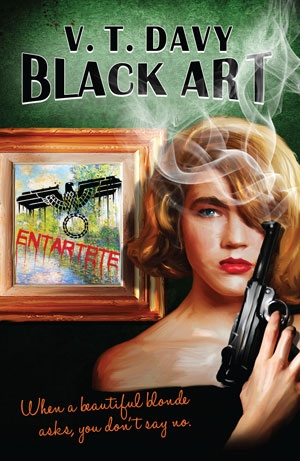Black Art
British actress Helen Valentine wants to know where she came from. Specifically, she wants to know about her grandmother, who disappeared in the early 1940s.
Author V. T. Davy is an amateur historian, and he gives Arty Shaw, his hero in Black Art, the same interest. In this noir-style mystery, genealogist Shaw is working on the latest episode of the television showRoots, tracing celebrities’ ancestry. His task is to investigate the unexplained disappearance decades earlier of Helen’s half-German, half-Jewish grandmother, Kay Marett. Set in the present day but focusing on events from the 1940s, Davy packs the novel with adventure—everything from espionage to art forgery to blackmail—and many twists and turns, as Arty uncovers events involving the German occupation of the Channel Islands during World War II. At first Arty believes Kay was deported, but he soon discovers the circumstances were much more complicated.
Davy engages readers, providing a unique take on the noir genre by centering the mystery around Helen’s heritage rather than a murder. The characters are also original: Arty, the investigator, is not a private detective but a genealogist, and is also transgendered, something that’s revealed through his interactions with Helen. The island where the story is set is unusual, too. Located off the coast of France, the British isle had been inhabited by the Germans in the 1940s; a tax loophole later attracted Londoners there in the ’60s and ’70s, which caused friction with the native islanders.
The many intricacies of the story can be difficult to follow at times, and all of the details are initially overwhelming, but Davy offers needed cues and reminders of earlier facts to assist readers by having Shaw explain his findings to several characters. The essence of the story is always clear: Helen is curious about her roots, and Arty is determined to uncover the truth, which makes the characters, and the story, relatable. The characters’ humor, particularly Arty’s, make them entertaining as well. Readers get to know Arty best, but they also learn much about Helen’s family, and the World War II era, through Arty’s “detective” work.
While Davy’s use of a staccato rhythm follows the noir tone clearly evoked from the cover art, it can be stilted at times, and may not appeal to those drawn strictly to the historical aspects but unfamiliar with the genre. The typeface is also smaller than standard and won’t be ideal for all readers.
This action-packed mystery will introduce readers to intriguing and memorable characters, and may even encourage them to investigate more about their own family history.
Reviewed by
Maria Siano
Disclosure: This article is not an endorsement, but a review. The publisher of this book provided free copies of the book and paid a small fee to have their book reviewed by a professional reviewer. Foreword Reviews and Clarion Reviews make no guarantee that the publisher will receive a positive review. Foreword Magazine, Inc. is disclosing this in accordance with the Federal Trade Commission’s 16 CFR, Part 255.

